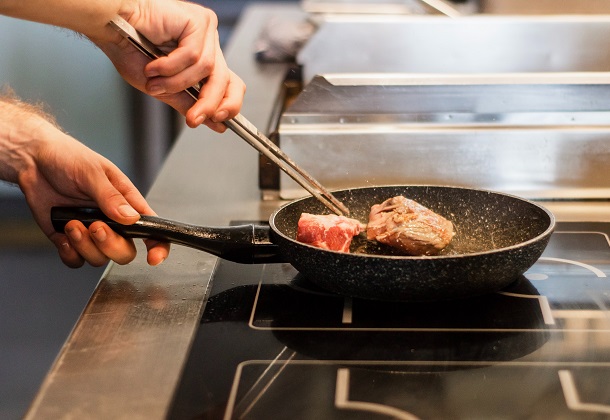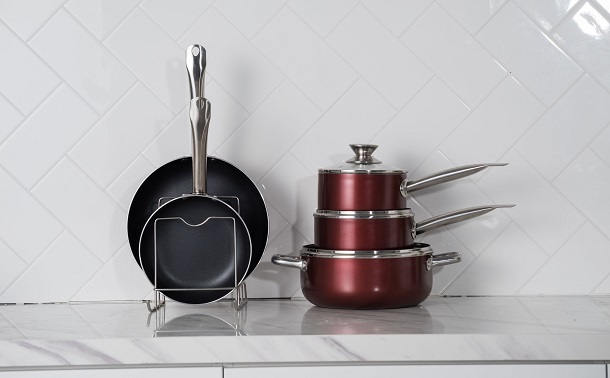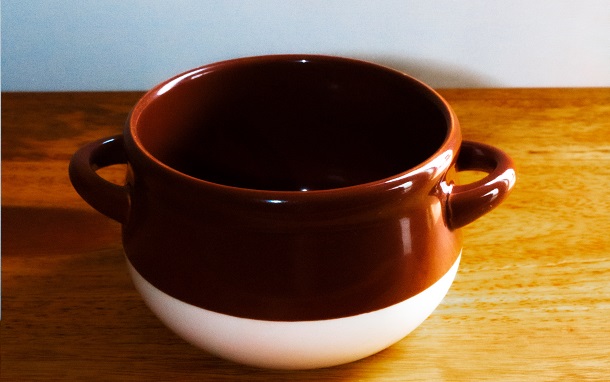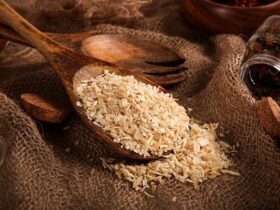You may notice more and more cookware in stores marked as “granite cookware”.
During the last several years it has become trendy thanks to its attractive color and interesting name.
Since we all want to make the right decision and do the best for our health, we have done the research and gathered all info you need to know about this popular cookware.
IN THIS ARTICLE:
What is Granite Cookware?
Actually, granite cookware refers to different types of kitchen cookware. Kitchen vessels marked as Granite are made from the metal base and covered with PTFE, vitreous enamel or some other type of coating (but rarely). So, despite its name, it doesn’t actually contain any granite. It has been named so because it resembles granite stone.
All granite cookware has only one common characteristic that it shares – a granite color pattern.
Granite is largely a marketing term. All non-stick cookware is made from either PTFE or ceramic and granite cookware is no exception.
I make this clarification because there is a lot of misinformation on the internet. Granite cookware may contain granite or other substances, but this is only in addition to the nonstick coating.


How Safe is Granite Cookware?
As you read in the section above, granite cookware refers to a whole variety of different cooking vessels in sense of coating and materials, so there is no consensus about safety.
So, it’s a bit hard to talk about granite health sides or risks if there is a whole variety of products sold under this name.
But vessels marked as PFOA, cadmium and lead-free delivered from reputable manufacturers hold lower health risks for customers. But, let’s take a closer look.
Closer Look at Granite Cookware
The core of the granite cookware is usually metal, and it differs from stainless steel to aluminum. The two main types of coating are vitreous enamel and Teflon (PTFE). Let’s check these two groups.
- Teflon (PFTE) Base Graniteware
When looking for granite cookware, first check the etiquette to see if there is more info about the coating. Sometimes PTFE (Teflon) is clearly marked, but sometimes there isn’t clear evidence the cookware is PTFE-free.
If there is no clear information, you can be sure the cookware contains PTFE. How else can you know? Cookware ticked like “mineral coating” usually refers to PFTE. Also, if the maximum heating is limited to around 260°C is a sign of PFTE coating.


Three main problems with Teflon:
- Toxic fumes that evaporate from PTFE at temperatures above 250°C (when searing, stir fry)
- Ingesting small pieces of PFTE coating in from your food
- Using different chemicals in the manufacturing process helps PTFE to stick to the cookware surface
Many studies show the strong toxic effect of byproducts made by PFTE degradation on high heat (even at lower temperatures, around 200°C). Temperatures around 200°C to 250°C can be easily achieved in everyday cooking practice.
This is a big concern when we talk about Teflon cookware.
2. Vitreous Enamel Graniteware
Vitreous enamel or porcelain enameled cookware also can be found on the market.
If you find cookware with the label “PTOA and PTFE free” it probably refers to vitreous enameled cookware.
That kind of cookware usually has a shiny glass luster similar to enameled cast iron. The cookware that is covered with porcelain enamel is actually covered with a type of glass and it doesn’t have anything with porcelain.


Unlike the PFTE counterpart, this kind of granite cookware doesn’t release toxic fumes at high temperatures. But if you use metal utensils, chipping of enamel coating can occur.
In general, enameled cookware is much more damage-resistant than PFTE ones. Vitreous enamel has lower sensitivity to high temperatures, so the manufacturers don’t set temperature limits.
But on the other hand, this type of coating can contain lead, so try to find the cookware that clearly stated that it is lead-free.
How to Use Granite Cookware to Keep Them Safe?
There are several basic rules you should follow to keep your cookware safe and long-lasting. These are proper maintaining and proper cooking practices.
- Proper Maintaining – Don’t use metal or ceramic utensils (use silicone or wood ones), use the lowest cooking temperature required for the certain food, avoid using Teflon cookware in the oven, always use a little bit of oil when frying, don’t use the dishwasher for cookware (try with baking soda) and do not expose cookware to water immediately after cooking.
- Proper Cooking Practices – Granite cookware is appropriate for acidic food and sauces, also you can use salt as much as you want during cooking. Cookware with indentation isn’t ideal for glass stovetops, but granite cookware with a flat bottom can be normally used on glass cooktops. Plus, proper storage is important. Don’t other cookware with hard surfaces on your granite cooking vessels.
What Are Signs of Safe and Good-quality Granite Cookware?
The first step is to read the product description and try to figure out what kind of cookware you’re buying.
Is it PFTE coating, vitreous enamel coating or something else?
Looking overall, vitreous enamel granite cookware has fewer health issues than PFTE ones, but buy it from reputable manufacturers.


Try to find cookware with a steel base rather than aluminum, because aluminum alloy can be toxic even in small quantities.
What Cookware Materials to Avoid?
Here we’ll mention what cookware materials are the best to avoid, backed by science. These are pure aluminum cookware, cookware with Teflon, PFTE and PFOA and copper cookware.
These materials are related to many serious health issues (Alzheimer’s disease, cancer, human reproduction illness, mental disorders, heart problems, etc.)
So, What Are Safe Cookware Materials?
As we already mentioned, these materials are safe stainless steel, safe ceramic, cast iron, stoneware, glass and titanium.
Without a doubt, new cookware materials have their advantages and disadvantages and it’s up to the customer to distinguish between them.
Granite Vs Ceramic Cookware
We have already discussed granite cookware, so let’s check ceramic cookware quickly.
Ceramic cookware is considered safer than Teflon because it’s free of harmful chemicals such as PFAS, PFOA and PFTE. It can be safely heated to higher temperatures than Teflon while maintaining a nonstick surface. It is relatively lightweight, and easy to wash by hand or in the dishwasher.


Of course, there are some disadvantages of ceramic cookware, such as metal utensils can easily damage the non-stick coating, which can bring the metal in direct contact with your food and cause health issues.
Plus, it has a shorter lifespan than most metal cookware.
To Wrap It Up
There is the chance that some other types of cookware hold the label “granite cookware”, but it will be wise to find ones that are clearly stated PFOA, PFTE, cadmium and lead-free. Unfortunately, this cookware isn’t totally safe but you’ll eliminate the most common hazards.

















Leave a Reply